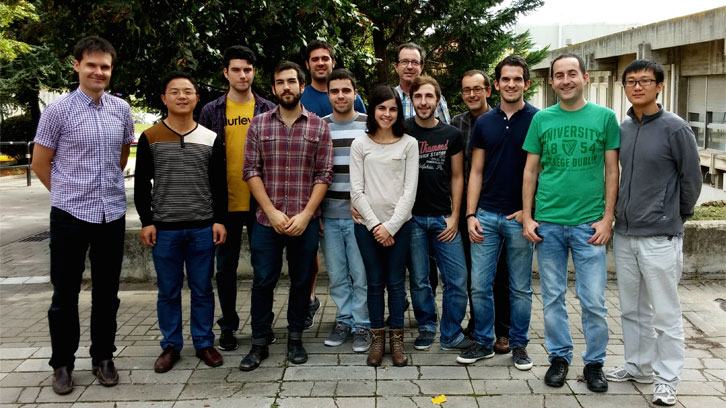Selective Oxidation Catalysis Research Group (SelOxCat)

The SelOxCat research group focuses on the design and preparation of molecular or colloidal systems based on transition metal and hybrid materials to be applied as oxidation-reduction catalysts. Particularly, the group is interested in the study, comprehension and development of key reactions for the production of renewable fuels from water and sunlight, such as the oxidation of water to dioxygen and the reduction of protons to hydrogen gas or the reduction of carbon dioxide to methanol or methane gas. It uses a wide range of techniques, including spectroscopy, electrochemistry, electronic microscopy and X-ray crystallography, in order to understand these processes at the molecular or atomic level.
The group was founded in 2011 within the Department of Chemistry of the UAB. It is currently led by the lecturers from the area of Inorganic Chemistry Xavier Sala, Jordi García-Antón, Roger Bofill and Lluís Escriche and includes five PhD students (Rosa Gonzalez, Jonathan De Tovar, Mark Gil, Jordi Creus, Bing Jiang), a masters student (Lluís Solà) and four undergraduate students.
Research Lines
The research conducted by SelOxCat is divided into three main lines:
Selective and sustainable oxidative transformations. Among the oxygenated products, epoxides (organic molecules formed by a ring of three atoms containing one oxygen atom) are of central importance in organic synthesis since they provide access to highly diverse molecules by means of subsequent transformations. In addition, their chiral derivatives (molecules that have the property of not being superimposable with their mirror image) constitute versatile intermediates for the synthesis of numerous natural products and biologically active substances. However, the most common methods of preparation are still based on the use of rather expensive oxygen-atom transfer oxidants or high loadings of toxic metals. Therefore, to develop selective/enantioselective (i.e., to distinguish between a molecule chiral and its enantiomer, which is another molecule given that it is the mirror image which is not superimposable on the first) and sustainable methodologies for preparing theses epoxides is the main goal of this research project.
New energy conversion schemes. Artificial photosynthesis. The dissociation of water by sunlight is an attractive alternative to photosynthesis, since it is a very clean and simple reaction from a chemical point of view. This process, called artificial photosynthesis, is based on the use of non-protein synthetic catalysts for the oxidation of water to molecular oxygen and reduction of water protons in hydrogen gas (high performance fuel) or reduction of atmospheric CO2 in energetic or synthetically useful (methane, methanol, formaldehyde, etc.) products. The overall objective of the group is to generate clean energy from water and sunlight by means of catalytic reactions harmoniously combined in a photoelectrochemical cell.
Use of nanoparticles in catalysis. Surface chemistry. The processes described above can also be carried out by means of nanosized materials (colloids, usually transition metals) stabilized by molecules attached to the surface (called ligands). The goal of this research line is based on the molecular characterization of nanoparticle-ligand interactions at the molecular level using spectroscopic techniques (NMR essentially) during the oxidative changes described above.
Selected publications from the past three years
AGUILÓ, J.; FRANCÀS, L.; BOFILL, R.; GIL-SEPULCRE, M.; GARCÍA-ANTÓN, J.; POATER, A.; LLOBET, A.; ESCRICHE, L.; MEYER, F.; SALA, X. Powerful Bis-facially Pyrazolate-Bridged Dinuclear Ruthenium Epoxidation Catalysts. Inorganic Chemistry. 2015, vol. 54, num. 14, p. 6782-6791. doi: 10.1021/acs.inorgchem.5b00641.
AGUILÓ, J.; FRANCÀS, L.; LIU, H.; BOFILL, R.; GARCÍA-ANTÓN, J.; BENET-BUCHHOLZ, J.; LLOBET, A.; SALA, X. Characterization and Performance of Electrostatically adsorbed Ru-Hbpp Water Oxidation Catalysts. Catalysis Science and Technology. 2014, vol. 4, 190-199. doi: 10.1039/C3CY00643C.
BOFILL, R.;GARCÍA-ANTÓN,J.;ESCRICHE, L.; SALA, X.Chemical, Electrochemical and Photochemical Molecular Water Oxidation Catalysts. Journal of Photochemistry and Photobiology B: Biology. 2015, vol. 152, part A, p. 71-81. doi: 10.1016/j.jphotobiol.2014.10.022.
BOFILL, R.; GARCÍA-ANTÓN, J.; ESCRICHE, L.; SALA, X.; LLOBET, A. Water Oxidation. REEDIJK, J.; POEPPELMEIER, K. (eds). Comprehensive Inorganic Chemistry II 2ond editon. Elsevier, 2013, vol. 8, chapter 8.13, p. 505-523. doi: 10.1016/B978-0-08-097774-4.00821-4.
FRANCÀS, L.; BOFILL, R.; GARCÍA-ANTÓN, J.; ESCRICHE, L.; SALA, X.; LLOBET, A. Ru-based Water Oxidation Catalysts.LLOBET, A. (ed). Molecular Water Oxidation Catalysts: A Key Topic for New Sutainable Energy Conversion Schemes. John Wiley & Sons, Ltd., 2014, p. 29-50. doi: 10.1002/9781118698648.ch3.
FRANCÀS, L.; GARCIA-GIL, R. M.; MOYANO, D.; BENET-BUCHHOLZ, J.; GARCÍA-ANTÓN, J.; ESCRICHE, L.; LLOBET, A.; SALA, X. Dinuclear Ruthenium Complexes Containing the Hpbl Ligand: Synthesis, Characterization, Linkage Isomerism, and Epoxidation Catalysis. Inorganic Chemistry. 2014, vol. 53, num. 19, p. 10394-10402. doi: 10.1021/ic501483s.
GARCÍA-ANTÓN, J.; BOFILL, R.; ESCRICHE, L.; LLOBET, A.; SALA, X. Transition metal complexes containing the dinucleating tetra-N dentate Hbpp ligand: a robust scaffold for multiple applications including the catalytic oxidation of water to dioxygen. European Journal of Inorganic Chemistry. 2012, num. 30, p. 4775-4789. doi: 10.1002/ejic.201200661.
MATHEU, R.; ERTEM, M. Z.; BENET-BUCHHOLZ, J.; CORONADO, E.; BATISTA, V. S.; SALA, X.; LLOBET, A. Intramolecular proton transfer boosts water oxidation catalyzed by a Ru complex. Journal of American Chemical Society. 2015, vol. 137, num. 33, p. 10786-10795. doi: 10.1021/jacs.5b06541.
MATHEU,R.;FRANCÀS,L.; CHERNEV, P.; ERTEM,M. Z.; BATISTA,V. S.; HAUMANN, M.; SALA, X.;LLOBET, A. Behavior of the Ru-bda Water Oxidation Catalyst Covalently Anchored on Glassy Carbon Electrodes. ACS Catalysis.2015, vol. 5, num. 6, p. 3422-3429. doi: 10.1021/acscatal.5b00132.
SALA, X.; MAJI, S.; BOFILL, R.; GARCÍA-ANTÓN, J.; ESCRICHE, L.; LLOBET, A. Molecular Water Oxidation Mechanisms Followed by Transition Metals: State of the Art. Accounts of Chemical Research. 2014, vol. 47, num. 2, p. 504-516. doi: 10.1021/ar400169p.
Xavier Sala
Jordi Garcia Antón
Lluís Escriche
SelOxCat Research Group
Department of Chemistry
Roger.Bofill@uab.cat, Xavier.Sala@uab.cat, Jordi.GarciaAnton@uab.cat, Lluis.Escriche@uab.cat


